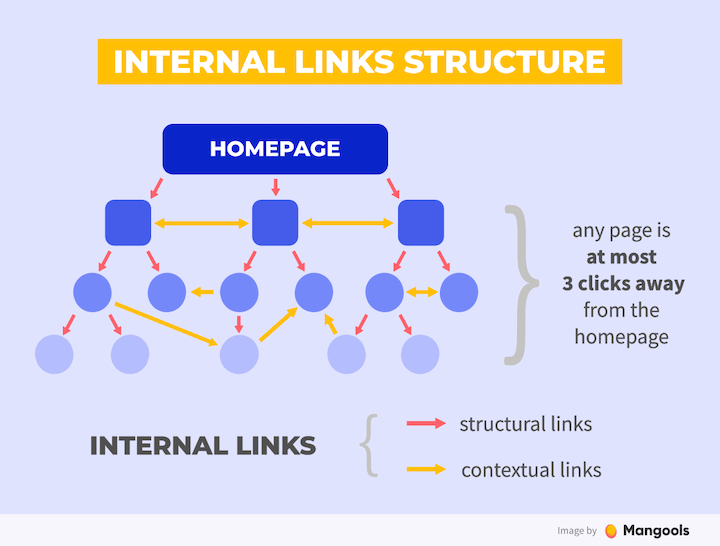Learn about the types of website interlinking and the advantages of internal linking. This guide, will explains the various methods of internal linking. It also outlines the benefits and best practices of internal linking. Read on for more. To get started, consider creating an internal link structure for your website. After creating an internal link structure, you should include related and relevant content within your website.
Internal linking Website
One of the biggest benefits of internal linking is that it helps spread link juice across your website. Link juice is the term for the equity or ranking power passed between websites. It translates to votes, and this power is a vital factor in ranking high in search results. By creating internal links within your site, you can identify pages with high amounts of authoritative links and distribute that link juice to other pages. This will help you control the amount of ranking power you pass on to your website.

Another benefit of internal linking is the ability to show related content. By linking content to internal pages, visitors can get a better understanding of the overall site. This will help your site rank higher, since Google crawlers will understand your site’s content and can better rank it. In order to make internal links more effective learn Link Wheel Formula for increasing website traffic, create topic clusters of related articles within your site. Another benefit is that internal linking will help you increase reader engagement, as well as reduce bounce rates. One of the most popular internal linking methods is to link articles that readers are likely to read. This can increase rankings on important pages, and can also improve the overall content quality of your site.

Website Interlinking Types
There are different types of Website interlinking. Some are more complex than others. Internal linking strengthens internal pages and makes them more authority. Internal links should be directed to pages with the lowest search volume. When implementing this type of interlinking strategy, make sure the pages are interlinked. The homepage usually has a lot of links, which is why you should use anchor text when linking to it. Besides, internal links should be contextual.
Internal links work like external links, but instead of directing visitors to another page, they point to a specific page within the website. The more internal links a page has, the more important it will be to search engines. This type of interlinking will increase the page’s ranking and give users a good experience, while increasing the number of pages to be linked. Internal links should be related to the content of the page they’re connected to, as this will make the link more valuable to search engines.
Advantages of internal link building
Internal link building helps improve SEO by spreading link juice among pages. It is crucial that internal links are directed to money pages, because Google rewards a website with more backlinks when these pages are linked to from other pages. However, internal linking requires ongoing maintenance. As such, it is important to audit your content regularly. However, if done properly, it can lead to significant improvements in your ranking. Here are some of the advantages of internal linking.
In addition to boosting your overall SEO performance, internal linking can also improve your site’s usability. Google considers these factors as a factor when it ranks pages, but if a link is broken, it cannot pass power. Besides, broken links can reduce your link equity and PageRank. So, building strong internal architecture is a winning strategy. But, how do you get started? Here are some simple steps you can follow.
Best Practices for Internal linking
Aside from generating more traffic, internal linking is a valuable tool for leveraging your digital presence. Many people invest in other actions to improve their Google positioning and organic traffic. However, they often neglect this important strategy. Internal linking strategies will not only improve your site’s usability, but will also increase the value of your content. Listed below are few best practices for internal linking.
Don’t let broken links break. Broken links hurt your credibility and authority among users and frustrate Google’s crawlers. Broken internal links can be fixed with the use of a technical SEO solution such as Deepcrawl. Make sure your homepage and product pages appear in the results of this tool. If any of these links are broken, you should fix them right away. Using an internal link audit tool, like Ahrefs, will give you valuable data on your site’s internal links.

Improves user experience
In terms of SEO, an effective internal linking strategy will help your audience find content quickly and easily. The purpose of internal linking isn’t only to pass link equity, but to ensure that crawlers can understand your site architecture. By creating internal links, you will give your audience more information about your business and your products, and this will improve your website’s SEO and user experience. Listed below are a few reasons why internal linking is so important for SEO.

An effective internal linking strategy will increase retention. It will reduce the bounce rate of visitors, which is the percentage of viewers who leave a website after only viewing one page. Good internal links should also be relevant and informative. Studies show that 70% of visitors use internal recommendations when going from one page to another. When designing your internal linking strategy, consider your user’s buyer’s journey. Are they at the top of the funnel? If so, they may need more information. Those at the middle may need a stronger call-to-action, while those at the bottom need a direct link to your product.
Internal linking Keeps users on Website Longer
Internal linking helps your website stay on top of Google’s search engine results. Visitors are more likely to remain on your site and complete the conversion action if you have internal links. This practice can help your website improve SEO by reducing bounce rates. It is important to keep these links up to date as Google tends to crawl authoritative pages more often. The longer a page stays on Google, the higher the search engine rank.
When implementing internal linking, make sure that you are including relevant, useful links in your content. These links should look natural and should not be placed in CTA boxes. Also, keep in mind that the context of the link is important – the majority of SEOs believe that links placed within the body copy are weighted more heavily than links placed in CTA boxes. While there are some exceptions to this rule, it is best to keep internal links in the first paragraph or at the top of your page.
Search Engine Crawling is Easy
There are several ways to improve SEO without having to resort to SEO experts. Adding internal links to your site is one of the easiest ways to improve search engine ranking. It can be done by creating relevant and natural links. Try to avoid placing internal links inside of CTA boxes, because these are not helpful to search engines. Also, consider the context of each link. It is believed that links within body copy are weighted more heavily than those in external links.
Use mid-search-volume keywords, such as “seo strategies” and “linking to authority” in your content. These keywords are more specific than the two-word keywords discussed above. They belong to the subject or product category of your blog, for example. Category pages should receive the most contextual internal links. The mid-search-volume keywords should be your top priority pages. This should help them gain higher page rankings.
Internal Linking Advanced Strategies
You’ve probably heard about internal linking and wondered how it can help you improve your SEO. While internal linking seems easy enough, it’s actually a complex process. There are a number of ways to optimize internal linking for your website and boost your search engine optimization. Here are some tips. First, include your target keyphrase in your link text. For example, you might want to include “learning cable installation safety tips” in your link text.
Another internal link strategy is bookmark links. Bookmark links focus on the relationship between multiple pages and improve usability. Bookmark links are also a great way to improve your website’s appearance in search results. Other internal linking techniques include keyword clustering, a hub-and-spoke strategy, and building an amazing HTML sitemap. These strategies all help improve your ranking. But how can you take advantage of them? It starts with a killer content marketing strategy. Creating lots of linkable content is crucial in this process. As you increase the number of internal links in your website, so will your rankings.





